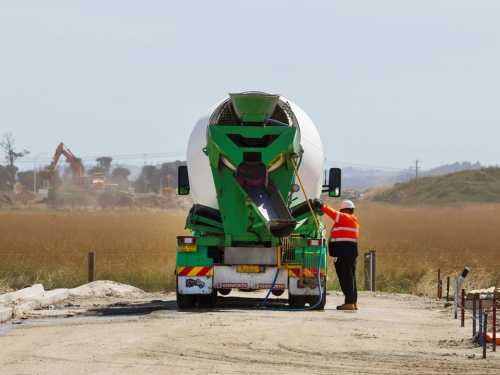
In this article, we will talk about fraud by sellers of ready-mixed concrete. Of course, not everyone does this.
A friend of mine worked as a concrete mixer driver, so all the information provided in the article is practically from the original source!
Let's note right away: a concrete mixer is a special equipment that mainly works in difficult conditions, so its parts and mechanisms are subject to accelerated wear. In addition, this equipment runs on diesel fuel with a consumption of 30 l/100 km, which is also not cheap! Therefore, in order to recoup costs and earn a good income, the owners of such special equipment do not behave quite honestly.
Looking ahead, I will note: we will only be able to recognize low-quality concrete after the fact, that is, after it has hardened, and this is a sad fact!
Why after the fact? Concrete is a mixture of natural components that always have different colors and consistencies. Our superficial assessment “by eye” is not a laboratory conclusion based on expert examinations. You may have heard the saying more than once: “If concrete is blue, it means there is more cement in the composition.” This is a false statement, since different plants use different raw materials, and it's like determining the percentage of meat in a sausage by its color!
So, a concrete mix has several basic parameters that are taken into account when ordering:
- Volume (V)
- Strength grade (M)
- Waterproof rating (W)
- Mixture mobility (P)
Most fraud occurs when ordering goods through ads that do not belong to the manufacturer. 99% of such ads are placed by a driver with his own concrete mixer truck (hereinafter referred to as a mixer) or a person who owns a small fleet of mixer trucks with hired drivers.
A good factory, believe me, also knows about advertising, but it doesn't hang ads on every pole. But a small entrepreneur, in order to survive in the conditions of competition, needs to advertise more aggressively – that's why we see signs on every pole in every village: “concrete”, “delivery of concrete”, “cheap concrete”. All this is the work of such entrepreneurs. And how can they survive in the conditions of huge competition? Of course, you need to lower the price, but keep quiet about the quality and say: “High quality, I have a special price from the factory”!
Scheme No. 1. Volume
The simplest scheme that cannot be checked is underloading. You will not be able to track the shortage of concrete during unloading. Of course, we are talking about volumes of more than 10-15 cubic meters. This is the first of the schemes where even an experienced person can be deceived, and this scheme is not checked even after the mixture has hardened. Any concrete mixture shrinks, any formwork has an error and deforms during pouring, any dug trench is not ideal.
An experienced scammer, after you contact him and discuss the details of the concrete supply, in 90% of cases will definitely come to the site only in his own interests: this is the main stage for him, at which he sets prices and looks closely, including at you!
Scheme No. 2. Brand
Scheme of underestimating the brand. It is impossible to visually distinguish the brand of concrete, even with a difference of 100 units (M100 and M150, M150 and M200, M200 and M300). Therefore, the compliance of the concrete class with the declared one is checked only after the mixture has hardened, after 28 days.
As soon as you hint that you are going to make “cubes”, 50% of drivers will “merge” (i.e. refuse) or recalculate the cost of the order. Others may ask to pour a cube from the first or last mixer, which also indicates that some cars will be underpriced.
Scheme No. 3. Additives (additives)
This is a scheme for underestimating the proportion of additives (additives) that improve certain properties of concrete. Whether it is the mobility of the mixture or the water resistance, it is always possible to intentionally underestimate the concentration.
The mobility of the mixture is, in other words, its plasticity. The higher the P index, the greater the fluidity. In practice, it is measured by the subsidence of the cone. The index varies from P1 to P5. Concrete with an index higher than P3 is used for concrete pumps, so that it is easier for the mechanism to pump the mixture.
There was a case when the customer ordered P4 concrete so that the mixture with increased fluidity would be easier to spread with shovels in the trench. The mixer driver was surprised when he arrived at the site: a concrete pump was waiting for him (you may have heard that if you pump a low-quality mixture with such a unit, it may simply fail). The driver turned around and drove away with his concrete. In order not to pour concrete and not lose a lot of money, the driver “by eye” brought the concrete to the desired consistency: he bought 10 bags of cement and 5 liters of liquid soap and dumped it all into his 9-cubic meter mixer.
But just so you know, adding such detergents, although it makes the mixture more plastic, CATASTROPHICALLY reduces the strength, frost resistance, and water resistance of hardened concrete, turning it into a brittle and short-lived material.
Scheme No. 4. Crushed stone
Replacing granite rubble with gravel.
Granite rubble is a rock that is extracted by crushing boulders to a certain fraction. Gravel rubble is most often extracted by sieving natural rocks.
Gravel is cheaper and has a rounded, smooth shape, respectively, and concrete turns out worse due to the lack of the necessary adhesion between natural and artificial stone.
Scheme No. 5. Bluff
This scheme occurs when ordering by “plate” and is a bit like a scam: a few hours before the concrete mix is delivered to the site, a problem is artificially created.
Imagine the situation: all the workers are on site, the customer has a concrete pump already at the construction site, the workers are gathered and waiting for the mixture to be delivered. And then suddenly the driver calls from the loading site and says: “The concrete production plant has broken down, some part has failed” (anything can break).
The customer is shocked, and his first thoughts are clear: “How is that? The workers came, they need to be paid, the concrete pump will definitely have to be paid for the minimum call.” And here the driver “rescues” the situation: “I know a quality plant, but I need time to get there. It won't take much time, but, however, concrete is a little more expensive there, and delivery will cost a little more.”
Do you understand what it leads to? The driver is loaded at the same factory that did not break down, but creates an emergency situation himself. Actors, in a word! :-)))
Other schemes are based on variations of these five.
How to protect yourself?
A supply contract is a mandatory condition. In fact, its conclusion takes no more than 30 minutes, since ready-made templates are already available at the factory.
Each concrete mixer truck must be accompanied by a wet-stamped concrete passport. The passport contains all four parameters mentioned above + frost resistance in cycles (F) and the date/time of loading. (If the supplier wants to deceive you, the drivers of the first mixers will always shout that the documents are in the last car).
Place your order yourself at the window at the factory or always be with the driver until the time of loading.
Of course, these tips do not guarantee the quality of the mixture, but they will help you to be safe. The main assessment of the quality of concrete is always checking its hardened state using standard methods:
- sclerometer (Schmidt hammer);
- ultrasound;
- compression of cubes.
Be careful! Good luck and good luck to you!






